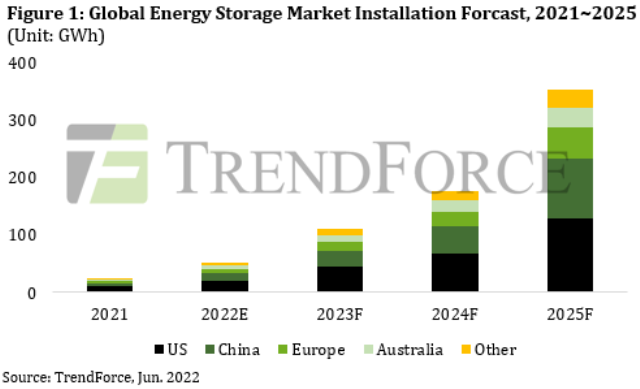In 2021, the global energy storage market maintained a high growth rate. Newly installed capacity was 29.6GWh, a YoY increase of 72.4 percent. The global energy storage market is forecast to usher in rapid development in the next 5 to 10 years with newly installed capacity at approximately 362GWh.
China will overtake Europe and the United States to become the energy storage market leader with primary growth momentum coming from the generation side.
TrendForce believes that China’s new energy storage will move towards being large-scale and market-oriented, forming an energy storage structure that is generation based, policy-driven, storage mandatory, and supplemented by the grid side (Transmission & Distribution) and consumer side (End User; including household, industrial, and commercial use). China’s energy storage market is expected to break through 100GWh by 2025.
In the United States, due to the current stagnation in newly installed pumped hydro storage capacity, future growth will focus on electrochemical energy storage. Newly installed capacity in the United States is predicted to reach 136GWh in 2025.
In Europe, thanks to policies and economic promotion, demand for energy storage installations has surged. Due to the Russian-Ukrainian war, the supply of natural gas and other energy sources in Europe has tightened and the cost of electricity has continued to rise, causing market panic. The EU has set a new energy installation target for 2030 which will stimulate demand for energy storage and newly installed capacity is predicted to reach 54GWh in 2025.
In the past, the global energy storage battery market was mainly dominated by Korean players such as LG and Samsung SDI.
With the accelerated deployment of Chinese energy storage battery manufacturers BYD and CATL, the cost advantage of energy storage systems has been highlighted and the market share of Chinese players has continued to expand.
Chinese energy storage battery manufacturers mainly use lithium iron phosphate while overseas manufacturers mainly use ternary lithium batteries. Due to safety concerns regarding ternary lithium batteries in recent years, general market acceptance is lower than that of lithium iron phosphate batteries.
Competition among leading companies such as Sungrow and SMA will intensify and concentration will increase further. System integration will present a relatively fragmented competition pattern with small and medium-sized companies in the majority and some leading upstream companies such as Sungrow and NextEra Energy in the mix.
The cumulative installed capacity of global renewable energy in 2021 was approximately 3,064GW (gigawatts), with an average annual growth rate of approximately 8-10 percent and 88 percent as the highest application of wind and solar energy in any area, according to TrendForce statistics.
Due to growth in the installed capacity of wind and solar energy, which increases the indirectness and volatility of power generation, energy storage has become an effective solution to the curtailment of wind and solar power (unutilized wind and solar energy), peak shaving, and frequency regulation (peak shaving refers to leveling peaks in electricity, balancing power generation and electricity consumption; frequency regulation refers to an effective way to change electricity quality and stabilize electricity frequency) demand.
Among all forms of energy storage, lithium battery energy storage technology represented by lithium iron phosphate has significant advantages over other energy storage technologies and is currently becoming the primary installed capacity of new energy storage around the world.

